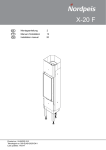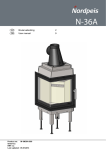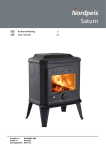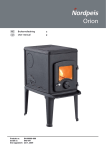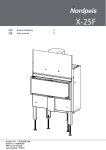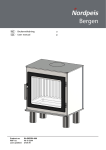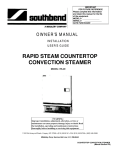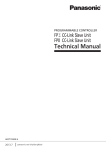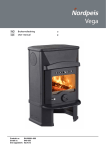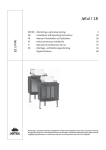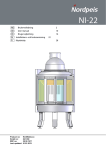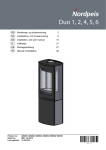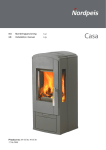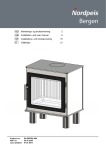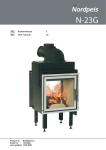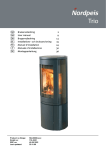Download X-20 F - Northstar
Transcript
X-20 F 7 NO 8 Brukerveiledning 9 10 User manual GB 2 11 12 9 A B C D E F G NAME 7 8 SIGNATURE DATE DRAWN P.Żabiński 2012-07-18 CHK'D D.Krzyżaniak 2013-11-29 APPV'D Ł.Kęsy 2013-11-29 WEIGHT: 91.90 (kg) Product no: IN-0X20F-010 Teknologisk no: 300-ELAB-2025-EN II Last updated: 130314 NAME: A2 IN-0X20F-010 X20F - Insert SCALE:1:5 MATERIAL: Q0 SHEET 1 OF 1 1 Innhold 1. Før du installerer nytt ildsted 1. Før du installerer nytt ildsted Skorsteinstrekk Tilførsel av luft 2. Teknisk informasjon 3. Sikkerhetsavstander 4. Montering Varmeskjold Montering og justering av ben Bakmontering Røykuttak og tilkobling Øvre varmeskjold Fjerning av selvlukkemekanismen Demontering av dør Kontroll av funksjoner 5. Første opptenning 6. Vedlikehold Rengjøring og inspisering Aske Thermotte™ Dør og glass 7. Garanti 8. Fyringstips 2 2 2 3 3 3 3 3 4 4 4 4 4 4 4 5 5 5 5 5 6 6 Råd og tips ved problemer med forbrenningen 7 Installasjon av nye ildsteder skal meldes til de lokale bygningsmyndigheter. Det anbefales å benytte kompetent personell ved installasjon nytt ildsted. Huseier står selv ansvarlig for at alle krav til sikkerhet er ivaretatt på en forskriftsmessig måte og er forpliktet til å få installasjonen inspisert og sikkerheten bekreftet av en kvalifisert kontrollør. Kvalifisert kontrollør kan være feier, murmester, varmeforhandler eller andre med tilstrekkelig kompetanse. Det er også en fordel å dokumentere denne kontrollen skriftlig, bruk gjerne vedlagte kontrollskjema. Lokalt feievesen må informeres dersom installasjonen medfører endret feiebehov. Skorsteinstrekk Sammenlignet med eldre ildsteder, stiller dagens rentbrennende ildsteder betydelig større krav til skorsteinen. Selv det beste ildsted vil fungere dårlig hvis skorsteinen ikke er riktig dimensjonert og i god stand. Oppdriften styres hovedsaklig av røykgasstemperatur, utetemperatur, lufttilførsel og skorsteinens høyde og innvendige diameter. Anbefalt skorsteinshøyde er minst 4 meter over røykinnføringen og en diameter på 150-200mm. Skorsteinens diameter skal aldri være mindre enn røykinnføringen/røykrøret. Ved nominell effekt skal det være et undertrykk i henhold til teknisk tabell. Trekken øker når: • skorsteinen blir varmere enn utelufta • den aktive lengden på skorsteinen over ildstedet økes • det er god lufttilførsel til forbrenningen Er skorsteinen overdimensjonert i forhold til ildstedet, kan det bli vanskelig å oppnå god trekk, fordi skorsteinen ikke blir godt nok oppvarmet. I slike tilfeller kan det lønne seg å ta kontakt med kynding personell for vurdering av eventuelle tiltak. For kraftig trekk kan avhjelpes med en trekkbegrenser. Ildstedet er typetestet og må kobles til skorsteiner som er dimensjonert for røykgasstemperatur som anvist i teknisk tabell. Ved behov, ta kontakt med en feier på forhånd. Tilførsel av luft (=mm AIR) Friskluftsett får å tilknytte ildstedet til luft utenfra fås kjøpt som tilbehør, og vil sikre at tilførsel av luft til ildstedet blir mindre påvirket av ventilasjonsanlegg, kjøkkenvifter og andre forhold som kan medføre undertrykk i rommet. I alle nybygg anbefaler vi på det sterkeste at det prosjekteres og klargjøres for direkte tilførsel av luft utenfra. Også i eldre hus kan bruk av friskluftsett anbefales. Utilstrekkelig tilførsel av luft utenfra kan medføre undertrykk i rommet der ildstedet står - og dermed dårlig forbrenning, dårligere utnyttelse av veden og nedsoting av skorsteinen. 2 NO For egen sikkerhet, følg monteringsanvisningen. Alle sikkerhetsavstander er minimumsavstander. Installasjon av ildsteder må i tillegg være i henhold til det enkelte lands lover og regler. Nordpeis AS står ikke ansvarlig for feilmontering av ildstedet. Røykgasstemperatur (°C) 275 °C Trekk (Pa) 12 Pa Brensel Ved Vedlengde (cm) 30 Vi tar forbehold om trykkfeil og endringer. Ileggsmengde (kg) 1,32 Ileggsintervall (min) 45 Driftsform Intermitterende* For sist oppdaterte versjon og mer utfyllende informasjon om brannmurer, pipetilkobling etc., se våre nettsider www.nordpeis.no *Med intermitterende forbrenning menes her vanlig bruk av et ildsted. Dvs at det legges i et nytt ilegg straks brenslet har brent ned til glør. 2. Teknisk informasjon Ildsteder fra Nordpeis har sekundærforbrenning og er rentbrennende. Ved sekundærforbrenning skjer forbrenningen i to trinn: Først brenner veden, deretter antennes røykgassene av forvarmet luft. Dette gjør at nye ildsteder har minimalt med utslipp av sotpartikler og uforbrente gasser (for eksempel CO) og er bedre for miljøet. Ved går under betegnelse fornybar ressurs/biobrensel. Rentbrennende ildsteder trenger lite ved for å oppnå god varmeeffekt. Fyr utelukkende med ren og tørr ved med fuktinnhold mellom 16% til 20%. Innsats X-20F Materiale Stål Overflatebehandling Varmebestandig lakk Vekt 92 Trekksystem Fyringsventil Forbrenningssystem Ren forbrenning Luftbehov (m³/h) 30 Anvendelig effektområde (rentbrennende) (kW) 3-4 kW Oppvarmingsareal (m2) 45-60 Maks vedlengde (cm) 40 Røykuttak Topp Røykstuss (Ø mm) Ytre Ø150 Røykgasstemperatur ved røykstuss (°C) 330 °C Anbefalt trekk ved røykstuss (Pa) >13 Røykavgass tetthet [g/s] 6,0 Data ihht til EN 13 229:2001 / A2:2004 Krav til innluftskanaler under innsats (cm2) 300 cm² Krav til utluftskanaler over 350 cm² innsats (cm2) Minimumsavstand fra utluftskanal til tak (mm) 400 Nominell effekt (kW) 4 kW Virkningsgrad (%) 76 % CO @ 13% O2 (%): 0,1 % Advarsel: Opprettholdes IKKE kravet til ventiler, vil effekten av varmesirkulasjonen bli vesentlig redusert og overoppheting kan oppstå. I verste fall kan dette resultere i brann. 3. Sikkerhetsavstander Brannmur Sørg for at angitte minimumsavstander overholdes (FIG 1). Ved toppmontering til stålpipe henviser vi til respektive fabrikats monteringsanvisning. Overhold de sikkerhetsavstandene montering av stålpipen krever. VIKTIG! Ved plassering av innsatsen på gulv av brennbart materiale må HELE gulvet innvendig i omrammingen dekkes av en stålplate med minimum 0,7 mm tykkelse. Gulvbelegg som teppe, nålfilt og lignene under stålplaten må fjernes. Da innsatsen ekspanderer under fyring må omrammingen ALDRI hvile på innsatsen, men ha en avstand på ca 3 mm. Innsatsen må heller ikke hvile på ileggsplaten eller mot sidene. Det anbefales å tørrstable peisomrammingen for å justere innsatsen før du tar hull i pipen til røykrøret. 4. Montering Varmeskjold FIG 3 Innsatsen er levert med fire varmeskjold. Se figur 3. Skjold A og D er allerede montert på innsatsen ved levering, B og C er pakket separat og må monteres. Montering og justering av ben FIG 4 Innsatsen er levert med justerbare ben. Disse monteres på innsatsen med medfølgende skiver og bolter (13 mm fastnøkkel). Juster bena til ønsket høyde før innsatsen løftes opp i NO 3 stående posistjon (ikke tipp!). Høyden på varierer etter valgt omramming. Bakmontering FIG 5, 6, 7 For å tilpasse innsatsen for bakmontering; 1. Hekt av de bakre varmeskjoldet (A) FIG 5. 2. Fjern utsparingen for bakmontering i varmeskjoldet (A), bruk beskyttelseshansker. 3. Skru av baklokket med to umbraco skruer. 4. Skru av røykstussen the flue collar. 5. Fest røykstussen på bakuttaket, og lokket på topputtaket med de samme skruene. 6. Hekt på det bakre varmeskjoldet (A). Røykuttak og tilkobling NB! Våre innsatser er utviklet for tilkobling av røykrør på utsiden* av røykstussen (Ø150). Montering av øvre varmeskjold FIG 8, 9, 10 1. Plasser øvre varmeskjold (B) på innsatsen som vist i FIG 8 2. Løsne skruen vist i FIG 9 - detalj A med cirka to runder. 3. Plasser øvre varmeskjold (C) på innsatsen. Pass på at sidehektene blir plassert riktig i sporene. Se FIG 9 & 10. Stram til skruen igjen. Fjerning av selvlukkemekanisme FIG 11 Selvlukkemekanismen er plassert under den nedre hengslen på døren. For å deaktivere denne, hekt forsiktig av den lange enden på fjæren - FIG 11. For å fjerne denne helt, ta av døren som vist i FIG 12. 5. Første opptenning Når ildstedet er installert og alle forskrifter er overholdt, kan det tennes opp. Unngå kraftige støt når det legges ved inn i brennkammeret da dette kan skade isolasjonsplatene. Vær oppmerksom på at fukt i isolasjonsplatene kan gi en treg forbrenning de første opptenningene. Dette vil løse seg når fuktigheten fordamper. Fyr evt. med døren på gløtt de 2-3 første gangene. Sørg også for god utluftning ved første fyring, da lakken på ildstedet vil avgi røyk og lukt. Røyken og lukten er ikke helseskadelig og vil forsvinne. Opptenning Legg inn tørr småved, tenn opp og la flammene få godt tak i veden før døren lukkes. Åpne opptenningsventilen når du lukker døren (FIG B). Når flammene er stabile og pipen er blitt varm, stenges opptenningsventilen. I motsatt fall kan ildstedet og pipen bli overopphetet. Når det er dannet et glødende kullag og flammene har dødd ut, kan ny ved legges inn. Dra glørne frem når du legger inn ny ved, slik at den nye veden antennes forfra. Døren skal settes på gløtt hver gang det legges i ny ved slik at flammene får godt tak. Bålet skal brenne med friske livlige flammer. Svært lav forbrenningseffekt og forsøk på fyring døgnet rundt er uheldig da dette gir økt forurensning og økt fare for skorsteinsbrann. Fyr aldri slik at ildsted eller rør blir rødglødende. Steng fyringsventilen hvis dette skjer. Optimal regulering av fyringsventilen krever litt erfaring. Når du har fyrt i ildstedet en stund, vil du finne en naturlig fyringsrytme. Fjerning av døren FIG 12 Fjern transportsikringen (A). Løft døren forsiktig opp (B) og dra den ut i bunnen (C). NB! Pass på å løfte døren høyt nok slik at hengslene ikke skader lakken i rammen. NB ! Husk alltid å åpne ventiler (og gjerne også døren) når det legges ny ved i et varmt brennkammer. La veden få ordentlig fyr før ventilinnstillingen reduseres. Ved lav trekk i skorsteinen og stengte ventiler kan gassene fra veden bli antent med et smell som kan forårsake skader på produktet og omgivelsene. Døren settes på plass igjen ved å følge anvisningen i omvendt rekkefølge FIG 12. Operational control Når innsatsen er oppstilt, og før innmuring, kontroller at funksjoner fungerer lett og virker tilfredsstillende. X-20F innsatsen er utstyrt med kun en fyringsventil. - + 6. Vedlikehold Rengjøring og inspisering Minst en gang i løpet av fyringssesongen bør ildstedet inspiseres grundig og rengjøres (gjerne i forbindelse med feiing av skorstein). Se til at alle sammenføyninger er tette, og at pakninger ligger riktig. Pakninger som er slitt eller deformert bør skiftes ut. Husk at ildstedet alltid må være kaldt før det inspiseres. Venstre posisjon (-) = minimum forbrenningsluft Høyre posisjon (+) = maksimum forbrenningsluft 4 Aske Asken må fjernes med jevne mellomrom. Vær oppmerksom på at asken kan inneholde glør selv flere døgn etter at ilden har opphørt. Det anbefales imidlertid NO å la det ligge igjen et lag aske i bunnen, da dette bidrar til å isolere brennkammeret. Bruk en beholder av ikke brennbart materiale når du fjerner asken. Innsatsen er levert med utstyr for å fjerne aske. For detaljerte tegninger, se FIG 22 & 23. Når det kun er glør igjen i brennkammeret, åpne fyringsventilen helt for å brene de siste kullbitene til aske. er tett og fungerer optimalt. Disse fås kjøpt i sett med keramisk lim inkludert. PEISGLASS KAN IKKE GJENVINNES Vær varsom med Thermotteplatene ved fjerning av aske, spesielt ved bruk av askespade. Peisglass skal kastes i restavfallet sammen med keramikk og porselen Thermotte™ De varmeisolerende platene i brennkammeret (FIG 3) bidrar til å gi høy forbrenningstemperatur, som fører til renere forbrenning av veden og høyere virkningsgrad. Eventuelle sprekker i platene forringer ikke isolasjonsevnen. Skulle det være behov for å erstatte eller bytte ut enkelte plater, kontakt din forhandler. Gjenvinning av glass Ildfast glass kan ikke gjenvinnes. Alt av gammelt peisglass, brekkasje eller annet ubrukelig ildfast glass, må kastes i restavfallet. Ildfast glass har høyrere smeltetemperatur, og kan derfor ikke gjenvinnes sammen med brukt emballasjeglass. Blandes dette med brukt emballasjeglass, ødelegges råvaren og gjenvinning av brukt emballasjeglass kan i verste fall stoppe. Når du sørger for at ildfast glass ikke havner i returpunktene, er det en hjelp som er et viktig bidrag for miljøet. Dersom det er nødvendig å ta ut thermotteplatene, gjøres dette omvendt av rekkefølgen beskrevet nedenfor. A. Høyre sideplate B. Venstre sideplate C. Røykvenderplate D. Bakplate E. Nedre høyre sideplate F. Nedre venstre sideplate G. Bunn H. Nedre front Se også FIG 14 - FIG 19 Gjenvinning av emballasje Emballasjen som følger produktet skal gjenvinnes etter det gjeldene lands forskrifter. 7. Garanti Merk: Ved bruk av for lang ved vil det medføre ekstra belastning som kan knekke platene, dersom veden blir liggende i spenn mellom sideplatene. For utførlig beskrivelse av garantibestemmelser, se vedlagte garantikort eller besøk våre nettsider www.nordpeis.no Vær også oppmerksom på at Thermotteplatene kan avgi farget støv ved berøring. Unngå å ta på lakkerte flater med støv på fingrene. Kommer det støv på noen av ildstedets synlige overflater er hansken som følger med godt egnet til å børste av med. CE merkingen er plassert på siden av innsatsen. 8. Fyringstips Dør og glass Dersom glassruten er sotete, kan det være nødvendig å pusse/rengjøre glasset. Bruk glassrens som er beregnet for dette (NB! Vær forsikting, glassrens kan skade lakken på dørrammen og pekninger). Brukes andre rengjøringsmidler kan det skade glasset. Et godt tips til rengjøring er å bruke en fuktig klut eller kjøkkenpapir med litt aske fra brennkammeret. Gni asken rundt på glasset og tørk av med et rent og fuktig kjøkkenpapir. NB! Rengjøring må kun gjøres når glasset er kaldt. Kontroller regelmessig at overgangen mellom glasset og døren er helt tett. Stram eventuelt til skruene som holder glasset på plass – men ikke for hardt, da dette kan føre til at glasset sprekker. Med jevne mellomrom kan det være nødvendig å skifte tetningslistene på døren for å sikre at ildstedet fortsatt Den beste måten å tenne opp et ildsted er ved bruk av opptenningsbriketter og kløyvet, tørr småved. Aviser gir mye aske og trykksverten er ikke bra for miljøet. Reklamer, magasiner, melkekartonger og lignende er ikke egnet for opptenning i peis. Det er viktig med god lufttilførsel ved opptenning. Når pipen blir varm øker trekken og døren kan lukkes. Advarsel: Bruk ALDRI opptenningsvæske som bensin, parafin, rødsprit eller lignende til opptenning. Du kan skade både deg selv og produktet Bruk alltid ren og tørr ved med et maksimalt fuktinnhold på 20%. Veden bør minimum tørkes et halvt år etter hugging. Fuktig ved krever mye luft til forbrenningen NO 5 fordi det må brukes ekstra energi/varme til å tørke ut det fuktige treet. Dette gir mindre varmeavgivelse til omgivelsene samtidig som det fører til sotdannelse på glasset og i pipen, med fare for beksot og pipebrann. Advarsel: Bruk ALDRI impregnert tre, malt tre, plastlaminat, kryssfiner, sponplater, avfall, melkekartonger, trykksaker eller lignende. Ved bruk av disse materialene bortfaller garantien, da de kan avgi dioksingasser som skader ildstedet når de forbrennes. Felles for disse materialene er at de under forbrenning kan danne saltsyre og tungmetaller som er skadelige for miljøet, deg og ildstedet. Saltsyren kan også angripe stålet i pipen eller murverket i en murt pipe. Unngå også å fyre med bark, sagspon eller annet ekstremt fint kløyvet ved unntatt ved opptenning. Denne form for brensel gir lett overtenning som kan resultere i for høy effekt. NB! Dersom pipebrann skulle oppstå, lukk døren, steng forbrenningsluften og ring brannvesenet. Etter en pipebrann skal pipen og ildstedet alltid inspiseres av autorisert personell før disse tas i bruk igjen. Lagring av ved For å forsikre seg om at veden er tørr, bør treet felles om vinteren og lagres om sommeren under tak på et sted med god utlufting. Vedstabelen må aldri dekkes av en presenning som ligger mot jorden, da presenningen vil fungere som et tett lokk som vil forhindre veden i å tørke. Oppbevar alltid en mindre mengde ved innendørs i noen dager før bruk, slik at fukten i overflaten på veden kan fordampe. Fyring Det er best å fyre jevnlig med en liten mengde ved. Hvis det legges for mange kubber på et glødelag vil det være for lite tilsig av luft til at temperaturen i brennkammeret blir høy nok. Ved for lav temperatur i brennkammeret forsvinner gass uforbrent ut igjennom pipen. Advarsel: Pass på at produktet ikke blir overopphetet – det kan føre til uopprettelig skade på peisen. Slike skader dekkes ikke av garantien. Kilde: “Håndbok, effektiv og miljøvennlig vedfyring” av Edvard Karlsvik SINTEF Energiforskning as og Heikki Oravainen, VTT. http://www.eufirewood.info For lite luft kan også medføre at glasset sotes. Tilfør derfor luft til bålet like etter at brenselet er lagt på, slik at det er flammer i brennkammeret og gassene forbrennes. Åpne opptennings-/fyringsventilen eller ha døren litt på gløtt til flammene får godt tak. Merk at lufttilførsel til forbrenningen også kan bli for stor og gi en ukontrollerbar flamme som svært raskt vil varme opp hele ildstedet til en ekstremt høy temperatur (gjelder fyring med lukket, eller nesten lukket dør). Fyll derfor aldri brennkammeret helt opp med ved. Valg av brensel Alle typer tre, som bjørk, bøk, eik, alm, ask og frukttre kan brukes som brensel i innsatsen. Tresorter har forskjellige hardhetsgrader - jo høyere hardhetsgrad veden har, desto høyere er energiverdien. Bøk, eik og bjørk har den høyeste hardhetsgraden. NB! Vi anbefaler ikke bruk av fyringsbriketter/ kompaktved i våre brennkamre, da disse produktene kan utvikle vesentlig høyere temperatur enn brennkammeret tåler. Fyringsbriketter/kompaktved anvendes på eget ansvarog kan føre til at garantien bortfaller. 6 NO Råd og tips ved problemer med forbrenningen Feil Manglende trekk Forklaring Utbedring Pipen er tilstoppet. Røykrøret er tilsotet, eller det er sotansamling på røykvenderplaten. Røykvenderplaten kan sitte galt. Kontakt feier/se fyrings DVD for ytterligere informasjon eller rens røykrør, røykvenderplate og brennkammer. Kontroller monteringen av røykvenderplaten - se bruksanvisning. Ildstedet ryker Undertrykk i rommet der ildstedet står. For lite trekk, under opptenning huset er for ”tett”. og drift Fyr opp med et åpent vindu i rommet. Hjelper dette, må det installeres flere/større ventiler til uteluft/friskluft i rommet. Undertrykk i rommet - kjøkkenvifte og/eller sentralt ventilasjonsanlegg trekker for mye luft ut av rommet. Slå av/reguler kjøkkenvifte og/eller annen ventilasjon. Hjelper dette må det settes inn flere ventiler i rommet Røykrør fra to ildsteder er tilsluttet skorsten i samme høyde. Monter om slik at høydeforskjell mellom røykrør er minst 30 cm Røykrøret heller nedover. Røykrør må flyttes slik at det er stigende fra ildsted til pipe, min. 10 grader. Evt. montering av røyksuger. Røykrøret stikker for langt inn i pipeløpet. Monter om røykrøret slik at det ikke stikker inn i pipeløpet, men avsluttes 5 mm før pipens innervegg. Evt. montering av røyksuger. Feieluke i kjeller eller loft står åpen og skaper falsk trekk. Feieluker må alltid være lukket. Utette eller defekte feieluker må skiftes. Spjeld/trekkventiler eller dører på ildsteder som ikke er i bruk står åpne og skaper falsk trekk. Steng spjeld, dører og trekkventiler på ildsteder som ikke er i bruk. Åpent hull i pipen etter fjernet ildsted skaper falsk trekk. Hull må mures igjen. Defekt murverk i pipen, f.eks. utetthet rundt rørgjennomføring og/eller ødelagt vegg i røykløp som skaper falsk trekk. Tett igjen og puss alle sprekker og utettheter. For stort tverrsnitt i pipen gir liten eller ingen trekk. Pipen må rehabiliteres, evt. montering av røyksuger*. For lite tverrsnitt, klarer ikke å transportere all røykgass ut Bytt til et mindre ildsted eller bygg ny pipe med større tverrsnitt. Evt. montering av røyksuger. For lav pipe som gir dårlig trekk. Øk pipehøyden og/eller monter pipehatt/røyksuger*. Ildstedet ryker inne når det er vind ute Pipen ligger for lavt i forhold til omkringliggende terreng, bygninger, trær e.l. Øk pipehøyden og/eller monter pipehatt/røyksuger*. Turbulens rundt pipen pga. for flatt tak. Øk pipehøyden og/eller monter pipehatt/røyksuger*. Ildstedet varmer for dårlig Ildstedet får for mye surstoff til forbrenningen pga lekkasje i underkant av ildstedet el. for stor pipetrekk. Vanskelig å regulere forbrenningen og veden brenner fort opp. Eventuelle lekkasjer må tettes. Trekken kan reduseres ved hjelp av en trekkbegrenser eller evt. spjeld. Obs! En lekkasje på bare 5 cm² er nok til at 30 % av den produserte varmluften forsvinner ”rett i pipa”. For mye trekk Røykvenderplaten kan sitte galt. Kontroller monteringen av røykvenderplaten - se bruksanvisning. Hvis du bruker ovnstørket tre, krever dette mindre lufttilførsel enn ved normal brensel. Skru ned lufttilførselen. Tetingslistene ved døren er nedslitte og flate. Skift ut tetningslistene hvis de er nedslitte, kontakt forhandler. Pipen er for stor. Kontakt feier/ovnsforhandler for ytterligere veiledning. Treet er for vått. Bruk kun tørr fyringsved med en maksimal fuktighet på 20 %. Luftventilen er lukket for mye. Åpne ventilen så det tilføres mer luft til forbrenningen. Ved ilegg av ny ved skal ventiler alltid ha full åpning eller det fyres med døren på gløtt til flammene får tak. Dårlig forbrenning (for lav temperatur i ovnen) Følg instruksjonene for riktig fyring som beskrevet. Feil fyring (fyring med avfallstre, malt tre, impregnert tre, plastlaminat, kryssfiner o.l.) Fyr utelukkende med ren og tørr ved. Det oppstår en trykkutjevning i brennkammeret. Lukk opp ventiler ca 1 min. før døren åpnes - unngå å åpne døren raskt. Døren åpnes når det er ild i brennkammeret. Åpne døren forsiktig og/eller kun ved gløding. Forbrenningstemperaturen er for lav. Øk lufttilførselen. Treet er for fuktig og inneholder vanndamp. Fyr utelukkende med ren og tørr ved. Ufullstendig forbrenning. Øk lufttilførselen. Glassruten sotes til Hvitt glass Røyk ut i stuen når døren åpnes Hvit røyk Svart eller gråsvart røyk NO 7 SJEKKLISTE OG BEKREFTELSE PÅ UTFØRT KONTROLL AV ILDSTEDSMONTERING Eiendommens adresse Gnr Bnr Tlf Eiers navn Adresse Postnummer Sted Montørens navn Adresse Postnummer Sted Ildstedstype og fabrikk Effekt i kW Brenseltype Skorstenstype (Eks. tegl, type elemtskorsten) Installasjonen er kontrollert av Adresse Dimensjon i cm² Ant. ildsteder på skorstenen Postnummer Sted Kvalifikasjon Følgende ble kontrollert av montør under installasjonen: Kontrollpunkt Ja Nei Er ildstedet montert etter monteringsanvisning? Er avstanden til brannmur kontrollert? Er avstanden til brennbart materiale kontrollert? Er avstanden til tak kontrollert? Er det plate under og foran ildstedet? Tåler gulvet vekten av ildsted med omramming? Er det feiemuligheter for ildsted og røykrør? Er ildstedet sikret nok tilførsel av forbrenningsluft via lufteventiler? Er røykrøret montert i skorstenen etter skorstensprodusentens anvisninger? Er skorstenen egnet for tilkobling av det aktuelle ildstedet? Har skorstenen passende dimensjon? Finnes produktdokumentasjon med monteringsanvisningen på byggeplass? Installert .................................................. ................................... .......................................................................... Sted Dato Montørens signatur KONTROLLERKLÆRING Installasjonen er kontrollert ved hjelp av: Utfylt sjekkliste Visuell kontroll Videokamera Annet: ....................................................................................................................................................................... .................................................................................................................................................................................. Installasjonen er kontrollert og funnet i orden: Kontrollert .................................................. ................................... ...................................................................... Sted Dato Kontrollørens signatur Det er en stor fordel at bekreftelse på kontroll av installasjonen finnes. Sørg for at denne siden blir utfylt, og ta vare på den. Dette er et verdipapir for boligen. Husk at huseier plikter å melde fra til kommunen ved brann- og feiervesenet om at ildstedet er montert. Send gjerne en kopi av denne siden til det lokale feiervesen. 8 NO Index 1. Prior to assembling the insert 1. Prior to assembling the insert Chimney Draft Air Supply 9 9 9 2. Technical Information 10 3. Safety distances 10 4. Assembly Radiation shields Assembling and adjusting the legs Rear flue gas connection Flue collar and connection Assembling upper covers Removing the self closing mechanism Removing the door Operational control 5. Lighting the fire for the first time 10 10 10 11 11 11 11 11 11 6. Maintenance Cleaning and inspection Ashes Thermotte™ Door and glass 12 12 12 12 12 7. Warranty 8. Advice on lighting a fire 13 13 Some advice in case of combustion problems 14 11 All our products are tested according to the latest European requirements and also to the Norwegian standard NS 3058 and NS 3059, which include particle tests. However, several European countries have local regulations for installation of fireplaces, which change regularly. It is the responsibility of the client that these regulations are complied with in the country/region where the fireplace is installed. Nordpeis AS is not responsible for incorrect installation. Important to check (please note that this list is not exhaustive): • distance from firebox to combustible/flammable materials • insulation materials/requirements between fireplace surround and back wall • size of floor plates in front of fireplace if required • flue connection between firebox and chimney • insulation requirements if flue passes through a flammable wall Chimney draft Compared with older models, the clean burning inserts of today put significantly higher demands on the chimney. Even the best insert will not work properly if the chimney does not have the right dimensions or is not in good working order. The draught is mainly controlled by gas temperature, outside temperature, air supply as well as the height and inner diameter of the chimney. The diameter of the chimney should never be less than that of the flue/chimney collar. For draft requirements at nominal heat output, see technical table The draught increases when: • The chimney becomes warmer than the outside air • The active length of the chimney over the hearth increases • Good air supply to the combustion It can be difficult to obtain the right draught conditions in case the chimney is too large relative to the insert, as the chimney does not heat up well enough. In such cases you may want to contact professional for evaluation of possible measures. Draught that is too strong can be controlled with a damper. If necessary, contact a chimney sweeper. Air supply A set for fresh air supply is available as an accessory. This will ensure that the air supply to the combustion chamber is less affected by ventilation systems, kitchen fans and other factors which can create a down-draught in the room. In all new constructions, we strongly recommend the product is designed and prepared for direct supply of outside air. In older houses also, the use of fresh air supply set is also recommended. Insufficient air supply can cause poor draught and thereby low combustion efficiency and the problems this GB 9 entails: soot stains on the glass, inefficient utilisation of the wood and a soot deposits in the chimney. CO @ 13% O2 (%) Flue gas temperature (°C) 275 For your own safety, fully comply with the assembly instructions. All safety distances are minimum distances. Installation of the insert must comply with the current rules and regulations of the country where the product is installed. Nordpeis AS is not responsible for wrongly assembled inserts. Inserts from Nordpeis all have secondary combustion and are clean burning. The combustion takes place in two phases: first the wood burns and then the gases from the fumes are lit by the heated air. This ensures that new inserts have minimal emissions of soot particles and un-burnt gases (such as CO) and are thus better for the environment. Clean burning inserts require a small amount of wood to obtain good heat output. Use exclusively clean and dry wood. We recommend seasoned hardwood with a maximum moisture content of 20%. Technical TABLE Insert X-20F Material Steel Surface treatment Heat resistant varnish Weight of insert (kg) 92 Draught system Ignition air vent control Combustion system Clean burning Combustion air consumption (m³/h) 8-16 Operating range, Clean burn (kW) 3-4 Heating area (m2) 45-60 Maximum fuel length (cm) 40 Flue outlet Top and rear Flue collar (Ø mm) Outer 150 330 Draft at flue connector recommended (Pa) 14-25 Data according to EN 13 229 Area of convection air vent under insert (cm2) 300 Area of convection air vent over insert (cm2) 350 Minimum distance conv. air outlet to ceiling (mm) 400 Nominal heat output (kW) 4,0 Efficiency (%) 76 10 >13 Fuel recommended: Wood logs Fuel charge (kg) 1,32 Refueling interval (minutes) 45 Operation* Intermittent* * Intermitent combustion refers to normal use of a fireplace, i.e. new wood is inserted when the previous load has burned down to ember Warning: If the requirements for ventilation are NOT complied with, the product can overheat. This can cause a fire. 3. Safety distances Firewall Ensure that the minimum safety distances are fullfiled (FIG 1). When connecting a steel chimney to the top outlet use the security distances required by the manufacturer. Important! When placing the insert on a combustible floor, a steel plate of at least 0.7mm must cover the entire floor surface inside the surround. Any flooring made of combustible material, such as linoleum, carpets etc. must be removed from underneath the steel plate. The insert expands when in use, and for this reason the surround must NEVER rest on the insert, but have a gap of about 3 mm. The insert must neither rest on the bench plate or against the sides. It is recommended to dry stack the surround in order to adjust the insert prior to perforating the chimney for the flue connection. *alternate versions exists due to nationa lrequirements Flue gas temperature at flue connector (°C) Draft (Pa) Fuel length recommended 30 (cm) Subject to errors and changes. For the latest updated version of the manual go to www. nordpeis.eu 2. Technical information 0,1 4. Assembly FIG 3 - to FIG 12 Radiation shields FIG 3 The insert is delivered with four radiation shields. See Figure 3. Covers A and D are already mounted at the insert prior to opening package, while cover B and C are packed separately. Assembling and adjusting the legs FIG 4 The insert is delivered with adjustable legs. The legs GB Operational control When the insert is in upright position, and prior to mounting the surround, control that all functions are easy to maneuver and appear satisfactory. The X-20F insert is equiped only with an Ignition vent control are mounted on to the insert using the added bolts and washers. Fasten the screws on to the insert with a 13 mm wrench. Adjust legs to the desired height before returning the insert to an upright position (do not tilt the insert). The height varries according to the surround. - Rear flue gas connection FIG 5, 6, 7 To utilize the rear connection on the insert, do as follows: + 1. Remove the rear radiation shield FIG 5. 2. Remove the cut in the rear radiation shield, use protective gloves. 3. Remove the plate covering the rear connection (two allen screws). 4. Remove the flue collar (two allen screws). 5. Move the flue collar to the rear outlet and the cover plate to the top connection (use the same screws). 6. Put back rear shield on the insert. Ignition vent control Left position (-) = minimum ignition air Right position (+) = maximum ignition air 5. Lighting a fire for the first time When the insert is assembled and all instructions have been observed, a fire can be lit. Take care when inserting logs into the burn chamber, in order not to damage the Thermotte plates. The horizontal mark on the back of the combustion chamber indicates maximum intended woodloading hight. See drawing FIG 13. Please note that there might be some humidity in the insulation lates which can result in a slower burn rate the first few times the insert is used. This will be resolved once the humidity has evaporated. If needed leave the door slightly open the first 2-3 times the insert is used. It is advisable to ventilate the room well when using for the first time as the varnish on the product may release some smoke or smell. Both the smoke and smell will disappear and are not hazardous. Flue collar and connection Attention! Our inserts are prepared for connecting the smoke pipe on the outside of the flue collar Ø150. *Alternative versions of the flue collar exist due to National requirements. For the flue connection to the chimney, follow the recomenndations from the chimney manufacturer. Assmebling Upper Covers FIG 8, 9, 10 1. Place rear upper cover on the insert as it is shown on FIG 8. 2. Loosen the screw shown on the FIG 9 - Detail A, unscrewing it by approximately 720 degree. 3. Take front upper cover - place on the Insert. Pay attention that small assembling plates, on the cover side, have to be inserted to the side slots of rear cover. See FIG 9 & 10. 4. The assembling is completed when cover is fastened by the screw - FIG 10 - Detail D. Removing the self closing door mechanism FIG 11 The self closing mechanism is located on the bottom hinge. To deactivate it, carefully unhook the long end of the spring. To completely the spring, remove the door as shown in FIG 12 Removing the door FIG 12 Remove door protection (A). Carefully lift the door up (B) and pull it out at the bottom (C). Attention! Be carefull to lift the door high enough so that the hinge does not scratch the paint on the frame. The door is installed by following the same steps in reverse order FIG 12. Lighting a fire Insert small, dry pieces of wood, ignite and ensure the flames have a good grip of the wood before closing the door. Open the ignition vent control as you close the door. When the flames are stable and the chimney is warm, close the ignition vent control. If it is not closed the insert and chimney may overheat When there is a glowing layer of ash, new wood logs can be inserted. Pull the hot ember to the front of the combustion chamber when inserting new logs so that the wood is ignited from the front. Keep the door slightly open each time new logs are inserted so that the flames get established. The fire should burn with bright and lively flames. Using the insert with low combustion effect and firing around the clock increase pollution as well as the risk for a fire in the chimney. Never allow the insert or flue to become glowing red. Turn off the air vent control should GB 11 this happen. Regulation of the air vent control takes some experience, but after a little while a natural rhythm for the fire will be found. IMPORTANT! Always remember to open the air vent control (preferably also the door) before new wood logs are inserted into a hot burn chamber. Let the flames get a good grip on the wood before the air control setting is reduced. When the draught in the chimney is low and the vent is closed, the gas from the firewood can be ignited with a bang. This can cause damage to the product as well as the immediate environment. 6. Maintenance FIG 14 - to FIG 23 Cleaning and inspection The insert should be inspected thoroughly and clened at least once per season (possibly in combination with the sweeping of the chimney and chimney pipes). To see how to get access to the chimney in order to chimney sweep see drawings from FIG 14 to FIG 21. Ensure that all joints are tight and that the gaskets are rightly positioned. Exchange any gaskets that are worn or deformed. Remember that the insert must always be cold when inspected. Ashes The ashes should be removed at regular intervals. Be aware that the ashes can contain hot ember even several days after the fire is finished. Use a container of non-combustible material to remove the ashes. It is recommended to leave a layer of ashes in the bottom as this further insulates the burn chamber. The insert is delivered with dedicated tools to remove ashes. For details see drawings FIG 22 & 23. When the fire is out and there is only ember left turn the Air ignition control to maximum in order to turn remaining charcoal into ash. In case it is necessary to take out the insulation plates, this is done in followieng order. A. Right side plate B. Left side plate C. Smoke baffle D. Back plate E. Right lower side F. Left lower side G. Bottom H. Lower front See also drawings from FIG 14 to FIG 19. Please note: Wood logs that are too long can cause additional strain and crack the plates, due to the tension created between the side plates. Please also note that the Thermotte plates may release coloured dust when touched. Avoid touching any cast iron parts with dust on your fingers. Any visible dust on cast iron can be brushed off with the glove that is included. Door and Glass Should there be any soot on the glass it may be necessary to clean it. Use dedicated glass cleaner, as other detergents may damage the glass. (NB! Be careful, even dedicated glass cleaner can damage the varnish on the door frame and the gaskets). A good advice for cleaning the glass is to use a damp cloth or kitchen roll paper and apply some ash from the burn chamber. Rub around the ash on the glass and finish off with a piece of clean and damp kitchen roll paper. NB! Only clean when the glass is cold. Check regularly that the transition between the glass and the door is completely tight. Possibly tighten the screws that hold the glass in place - but not too hard, as this can cause the glass to crack. Periodically, it may be necessary to change the gaskets on the door to ensure that the burn chamber is air tight and working optimally. These gaskets can be bought as a set, usually including ceramic glue. CERAMIC GLASS CANNOT BE RECYCLED Take care with the Thermotte plates when the ashes are removed, particularly when using an ash shovel, so as not to damage them. Thermotte™ These insulating plates in the burn chamber (FIG 2) contribute to a high combustion temperature, which leads to cleaner combustion of the wood and a higher rate of efficiency. Any fissures in the plates will not reduce their insulation efficiency. If new plates are needed, contact your dealer. Ceramic glass should be disposed of as residual waste, together with pottery and porcelain Recycling of ceramic glass Ceramic glass cannot be recycled. Old glass, breakage or otherwise unusable ceramic glass must be discarded 12 GB as residual waste. Ceramic glass has a higher melting temperature, and can therefore not be recycled together with glass. If mixed with ordinary glass, it would damage the raw material and could, in worst case end the recycling of glass. It is an important contribution to the environment to ensure that ceramic glass does not end up with the recycling of ordinary glass. Packaging Recycle The packaging accompanying the product should be recycled according to national regulations. Usage Not enough air to the combustion may cause the glass to soot. Hence, supply the fire with air just after the wood is added, so that the flames and gases in the combustion chamber are properly burnt. Open the air vent and have the door slightly ajar in order for the flames to establish properly on the wood. Note that the air supply for the combustion also can be too large and cause an uncontrollable fire that very quickly heats up the whole combustion chamber to an extremely high temperature (when using with a closed or nearly closed door). For this reason you should never fill the combustion chamber completely with wood. 7. Warranty For detailed description of the warranty conditions see the enclosed warranty card or visit our website www.nordpeis.eu The CE mark is placed on the side of the insert. 8. Advice on lighting a fire The best way to light a fire is with the use of lightening briquettes and dry kindling wood. Newspapers cause a lot of ash and the ink is damaging for the environment. Advertising flyers, magazines, milk cartons and similar are not suitable for lighting a fire. Good air supply is important at ignition. When the flue is hot the draught increases and door can be closed Warning: NEVER use a lighting fuel such as petrol, karosine, alcohol or similar for lighting a fire. This could cause injury to you as well as damaging the product. small amount of wood indoors for a few days before use so that moisture in the surface of the wood can evaporate. Choice of fuel All types of wood, such as birch, beech, oak, elm, ash and fruit trees, can be used as fuel in the insert. Wood species have different degrees of density - the more dense the wood is, the higher the energy value. Beech, oak and birch has the highest density. Attention! We do not recommend using fuel briquettes/ compact wood in our products. Use of such fuel may cause the product to overheat and exceed the temperatures determined safe. Burning briquettes/ compact wood is done so at your own risk and only small amounts (max 1/3 of normal load) should be used for each load. Warning: NEVER use impregnated wood, painted wood, plywood, chipboard, rubbish, milk cartons, printed material or similar. If any of these items are used as fuel the warranty is invalid. Use clean and dry wood with a maximum moisture content of 20%. The wood should be dried for a minimum of 6 months after it is cut. Humid wood requires a lot of air for the combustion, as extra energy/ heat is required for drying the humid wood and the heat effect is therefore minimal. This in addition creates soot in the chimney with the risk of creosote and chimney fire. Common to these materials is that during combustion they can form hydrochloric acid and heavy metals that are harmful to the environment, yourself and the insert. Hydrochloric acid can also corrode the steel in the chimney or masonry in a masonry chimney. Also, avoid burning with bark, sawdust or other extremely fine wood, apart from when lighting a fire. This form of fuel can easily cause a flashover that can lead to temperatures that are too high. In case of a chimney fire, close the door and air supplies on the stove / insert and call the Fire Brigade. After a chimney fire the chimney must in all cases be inspected by an authorized chimney sweeper before you use the appliance again. Storing of wood In order to ensure that the wood is dry, the tree should be cut in winter and stored during the summer, covered and in a location with adequate ventilation. The wood pile must never be covered by a tarpaulin lying against the ground as the tarpaulin will then act as a sealed lid that will prevent the wood from drying. Always keep a Warning: Make sure the insert is not overheated it can cause irreparable damage to the product. Such damage is not covered by the warranty. Source “Håndbok, effektiv og miljøvennlig vedfyring” by Edvard Karlsvik SINTEF Energy Research AS and Heikki Oravainen, VTT. http//www.eufirewood.info GB 13 Some advice in case of combustion problems Error Explanation Solution The chimney is blocked. No draught The smoke baffle is wrongly positioned. Verify the assembly of the smoke baffle - see assembly instructions. Downdraught in the room caused by no draught, that the house is too “air tight”. Light the fire with an open window. If this helps, more/bigger vents must be installed in the room. Downdraught in the room – caused by extractor and/or central ventilation system that pulls too much air out of the room. Turn off/regulate extractor and/or other ventilation. If this helps, more vents must be installed. The flues from two fireplaces/stoves are connected to the same chimney at the same height. One flue must be repositioned. The height difference of the two flue pipes must be of at least 30 cm. The flue is in a declining position from the smoke dome to the chimney. The flue must be moved so that there is an inclination of at least 10º from smoke dome to chimney. Possibly install a smoke suction device*. The flue is too far into the chimney. The flue must be reconnected so that it does not enter into the chimney but ends 5 mm before the chimney inner wall. Possibly install a smoke suction device*. Soot hatch in the basement or attic that is open and thus creating a false draught. Soot hatches must always be closed. Hatches that are not tight or are defected must be changed. Damper/top draught vents or doors on fireplaces that are not in use are open and create a false draught. Close damper, doors and top draught vents on fireplaces that are not in use. An open hole in the chimney after that a fireplace has been removed, thus creating a false draught. Holes must be completely sealed off with masonry. Defect masonry in the chimney, e.g. it is not airtight around the flue pipe entry and/or broken partition inside the chimney creating a false draught. Seal and plaster all cracks and sites that are not tight. The cross-section in the chimney is too large which results in no or very low draught. The chimney must be refitted, possibly install a smoke suction device*. The cross-section in the chimney is too small and the chimney cannot carry out all the smoke. Change to a smaller fireplace or build new chimney with a larger cross section. Possibly install a smoke suction device*. The chimney is too low and hence a poor draught. Increase the height of the chimney and/or install a chimney cap/ smoke suction device*. The chimney is too low in relationship to the surrounding terrain, buildings, trees etc. Increase the height of the chimney and/or install a chimney cap/ smoke suction device*. Turbulence around the chimney due to the roof being too flat. Increase the height of the chimney and/or install a chimney cap/ smoke suction device*. The fireplace combustion receives too much oxygen due to a leakage under the lower border of the insert or too strong chimney draught. Difficult to regulate the combustion and the wood burn up too quickly. Any possible leakage must be sealed off. A draught regulator or possibly a damper can reduce the chimney draught. NB! A leakage of only 5 cm2 is enough for 30% of the heated air to disappear. The smoke buffer is wrongly positioned. Verify the positioning of the smoke buffer – see assembly instructions. In case of using oven-dried wood, this requires less air supply than when using normal wood. Turn down the air supply. The gaskets around the door are worn and totally flat. Replace the gaskets, contact your dealer. The chimney is too large. Contact chimneysweeper or other professional for more details. The wood is too wet. Only use dry wood with a humidity of maximum 20%. The air vent control is closed too tightly. Open the air vent control to add air to the combustion. When new wood logs are inserted all vent controls should be completely opened or the door slightly opened until the flames have a good take on the wood. Bad combustion (the temperature is too low). Follow the guidelines in this user guide for correct combustion. White glass Using wrong material for combustion (such as: painted or impregnated wood, plastic laminate, plywood etc). Ensure to use only dry and clean wood. Smoke is released when the door is opened A levelling out of pressure occurs in the burn chamber. Open the air vent control for about 1 min before opening the door – avoid opening the door too quickly. The door is opened when there is a fire in the burn chamber. Open the door carefully and/or only when there is hot ember. The combustion temperature is too low. Increase the air supply. The wood is humid and contains water damp. Ensure to use only dry and clean wood. Insufficient combustion. Increase the air supply. The insert release smoke when lighting the fire and during combustion The fireplace releases smoke inside when it is windy outside. The fireplace does not heat sufficiently. Too much draught The glass is sooty White smoke Black or grey/ black smoke 14 Contact a chimney sweeper / dealer for more information or clean the flue, smoke baffle and burn chamber. The flue is sooty or there is accumulated soot on the smoke baffle. GB A Description: DRAWN P.Żabiński 2012-07-18 A - CHK'D UpperD.Krzyżaniak air connector (optional) WEIGHT: 93.98 (kg) Ł.Kęsy B - APPV'D Lower air connector NAME D SIGNATURE DATE MATERIAL: 1203 52 2 78 164 118 236 A 25 1188-1348 1057 580 48 150 325 34 1 215-345 185 1082 A 28 95 179 This document is Nordpeis (Northstar Sp. z o.o.) exclusive intellectual property. It must be treated as strictly confidential and must not be copied or communicated to any third person without Nordpeis (Northstar Sp. z o.o.) written permission X-20F=mm AIR 3 4 331 150 B 131,5 B 187 37,5 72,5 318 290 C 164 37,5 E B 284 F IN-0X20F-010 X20F - Insert NAME: SCALE:1:10 A4 Q0 SHEET 2 OF 2 15 This document is Nordpeis (Northstar Sp. z o.o.)exclusive intellectual property. It must be treated as strictly confidential and must not be copied or communicated to any third person without Nordpeis (Northstar Sp. z o.o.) written permission D ≥ 400 mm 1 1 3 2 2 4 3 3 70 5 4 4 70 ≥350cm2 5 F 5 7 A A 6 6 7 7 8 8 DRAWN P.Żabiński 2012-07-18 CHK'D D.Krzyżaniak 2013-11-29 APPV'D Ł.Kęsy F NAME 8 SIGNATURE 9 DRAWN P.Żabiński CHK'D D.Krzyżaniak APPV'D Ł.Kęsy NAME SIGNATURE 3 6 2 2 1 1 n 4 E 5 30 30 6 D 7 C 8 B =Brennbart materiale/Brændbart materiale/ Brännbart material/ Tulenarka materiaali/ Combustible material F F G G H 2013-11-29 WEIGHT: 91.90 (kg) DATE NAME: IN-0X20F-010 X20F - Insert 2013-11-29 WEIGHT: 91.90 (kg) 2012-07-18 DATE MATERIAL: R - radius to furniture (combustible) Description: 10 MATERIAL: Q0 11 SHEET 1 OF 1 SCALE:1:5 A2 A A B B C C D D E E ≥300cm2 F G G H 16 2013-11-29 NAME: IN-0X20F-010 X20F - Insert Q0 SHEET 1 OF 1 SCALE:1:5 A2 R≥700 30 A-A Beskrivelse: R - Radius til møbler (brennbar) 12 NA M P.Ż E ab ińsk i nia k rzy ża ęsy E Ł.K E D.K DR AW CH N K'D PV 'D =Brannmur/ Brandmur/ Palomuuri/ Firewall AP 20 12 RE DA TE -0 20 7-1 13 8 -1 20 1-2 13 9 -1 1-2 9 W EIG HT: 91 .90 SIG NA TU A (k g) 1 FIG 1 l a o nti si e is d rm nfi e o p c n tly tte ric ri st w s .) a .o d o te . z a p e S tr r e a b hst rt ust o m (N G It is y. e rt p e rd p o ro t N lp u a o tu ith c w lle n te o in ers e p siv d lu thir xc e y .) an .o o to .z d p te rS a a nic hst u rt m o m (N o H is r c e o p d rd o ie N op is c nt e e tb o um n c o ust d is m Th nd a 750 This document is Nordpeis (Northstar Sp. z o.o.)exclusive intellectual property. It must be treated as strictly confidential and must not be copied or communicated to any third person without Nordpeis (Northstar Sp. z o.o.) written permission D M ATE RIA L: IN D -0 NA F-0 M E: X2 0 10 X2 2 NO Du trenger følgende verktøy GB You need following tools 4 mm 10 mm 5 mm 13 mm 24 mm 17 FIG 2 Thermotte ®™ C B A D E F G H 18 Montering / Assembling FIG 3 B C A D FIG 4 215-345 215-330 185 185 13 mm 24 mm 46 46 19 FIG 5 FIG 6 10 mm 5 mm 20 FIG 7 FIG 8 21 FIG 9 FIG 10 22 FIG 11 FIG 12 23 FIG 13A Fjern hvelv beskyttelse / Removing Baffle plate protection bracket FIG 13B Maks ved mengde merke / Max wood load mark 24 Vedlikehold / Maintenance FIG 14 4 mm x2 FIG 15 25 FIG 16 FIG 17 26 FIG 18 FIG 19 27 FIG 20 FIG 21 28 FIG 22 NO NB!: Asken kan inneholde glør opptil 48 timer etter siste ilegg. Se til at det ikke er glør før bruk av askesugeren. GB CAUTION!: Ash may contain burning charcoal up to 48 hrs after the last fire is out. Before removing the ash with the separator, make sure there are no burning charcoal left in the ash. FIG 23 29 Nordpeis AS, Gjellebekkstubben 11, N-3420 LIERSKOGEN, Norway www.nordpeis.no 30






























